Tectonic Controls on Late Paleozoic Shale Gas Preservation in Western Shandong, China
Abstract
1. Introduction
2. Regional Geological Setting
3. Materials and Methods
3.1. Research Methods for Geological Structure Evolution
3.2. Testing and Analysis Methods for Hydrocarbon Source Rocks
3.3. Reservoir Testing and Analysis Methods
3.4. Basin Simulation Methods
4. Results
4.1. Late Paleozoic Shale Gas Source and Reservoir Formation Conditions in Western Shandong
4.1.1. Source Rock Development Characteristics
4.1.2. Organic Geochemical Characteristics of Source Rocks
- (1)
- Organic Matter Abundance
- (2)
- Kerogen Types
- (3)
- Thermal Maturity of Organic Matter
- (4)
- Summary
4.1.3. Hydrocarbon Generation Evolution of Source Rocks
4.1.4. Shale Gas Reservoir Characteristics
- (1)
- Mineralogical Composition
- (2)
- Fracture and Pore Development Characteristics
- (3)
- Permeability
- (4)
- Summary
- Marine mudshales in the Taiyuan Formation exhibit good lateral continuity and stable physical properties, while Shanxi Formation mudshales, affected by fluvial erosion, contain interbedded sandstones and coal seams, leading to strong vertical heterogeneity in reservoir properties;
- Target intervals are mostly buried at 1500–3000 m, with stress regimes dominated by compressional-shear stress. The horizontal principal stress difference ranges from 5 to 15 MPa, influencing the propagation direction of hydraulic fractures;
- Reservoir compaction and cementation (carbonate cementation) reduce porosity, while late-stage dissolution (organic acid alteration) locally improves storage space;
- The Taiyuan–Shanxi Formations feature moderate organic matter maturity, high brittle mineral content, and a foundation for fracture stimulation, endowing this shale interval with exploration potential. However, challenges such as low porosity/permeability and strong heterogeneity remain.
4.2. Structural Evolution and Sedimentary Response Characteristics
4.2.1. Structural Evolution Processes
- (1)
- Crustal Block Formation Stage (Pre-Caledonian Period)
- (2)
- Crustal Block Development Stage (Caledonian to Hercynian Periods)
- (3)
- Compressional Uplift Stage (Indosinian to Yanshanian Periods)
- (4)
- Faulting and Fragmentation Stage (Yanshanian Period to First Phase of the Himalayan Orogeny)
- (5)
- Re-subsidence Stage (Since the Second Phase of the Himalayan Orogeny)
4.2.2. Sedimentary Response Characteristics of the Late Paleozoic
4.3. Shale Gas Preservation Conditions in the Western Shandong
4.3.1. Controlling Effects of Tectonic Activity on Shale Gas Preservation in Western Shandong
- Destructive effects: Active fault zones may form escape pathways for shale gas, particularly in areas with intense tectonic activity, such as around steep normal faults with high vertical movement rates.
- Constructive effects: Faults in stable periods can act as trap boundaries, and fault-block structures formed by detachment combinations, and steep faults can locally seal gas accumulations.
- (1)
- Negative Impacts of Fault Systems and Tectonic Activity on Shale Gas Preservation
- (2)
- Positive Impacts of Multi-Phase Structural Superposition
4.3.2. Matching Relationship Between Tectonic Movements and Gas Generation Peak of Target Intervals
4.3.3. Comprehensive Evaluation of Shale Gas Preservation Conditions in Western Shandong
5. Discussion
5.1. Comprehensive Analysis of Key Findings
5.2. Uncertainty Analysis and Future Research Directions
5.3. Implications for Future Exploration
6. Conclusions
- Coupling analysis of burial history, thermal history, and structural history, revealed that the Carboniferous Permian shale gas reservoirs in Western Shandong region have undergone a complex evolutionary sequence of “tension–subsidence–compression erosion–resubsidence”, including basement uplift during the Hercynian period, compression folding during the Indosinian period, fault block activity during the Yanshanian period, and differential subsidence during the Himalayan period. Influenced by this tectonic evolution process, the Late Carboniferous Taiyuan Formation and Early Permian Shanxi Formation in the study area belong to the marine continental sedimentary system in the southeastern part of the North China Platform.
- Geochemical analysis showed that the organic carbon content (TOC) of shale in Taiyuan Formation and Shanxi Formation ranges from 1.0% to 4.5%, and the kerogen is mainly of type II2–III. The Ro values show a “north–south zoning” characteristic: 0.7–1.3% in Jining Sag (mature stage), 2.0% in Yutai Sag (over mature stage), and 1.0–1.3% in Chengwu Sag (mature stage). The central region is currently in the stage of abundant shale gas generation.
- The key control factors for preservation conditions include establishing a three in one preservation evaluation model of “structure–stratigraphy–thermal evolution”: a structurally stable zone (located at a distance of more than 10 km from the throughgoing fault, without large cracks), a burial depth range of 2000–4000 m, TOC > 2.5%, and an area with a single layer thickness of shale > 20 m have the best preservation potential. Several layers of limestone have developed in the lower part of the Taiyuan Formation of the Lower Permian, while multiple sets of mudstone and argillaceous sandstone have developed in the Shihezi Formation of the Upper Permian, providing good bottom and top plates for shale gas reservoirs, which can effectively seal and protect shale gas shale reservoirs.
Author Contributions
Funding
Data Availability Statement
Conflicts of Interest
References
- Li, X.J.; Hu, S.Y.; Cheng, K.M. Suggestions from the development of fractured shale gas in North America. Pet. Explor. Dev. 2007, 392–400. [Google Scholar] [CrossRef]
- Nie, H.K.; Zhang, J.C.; Zhang, P.X.; Song, X.W. Shale Gas Reservoir Characteristics of Barnett Shale Gas Reservoir in Fort Worth Basin. Geol. Sci. Technol. Inf. 2009, 28, 87–93. [Google Scholar] [CrossRef]
- Zeng, X.L.; Liu, S.G.; Huang, W.M.; Zhang, C.J. Comparison of Silurian Longmaxi Formation shale of Sichuan Basin in China and Carboniferous Barnett Formation shale of Fort Worth Basin in United States. Geol. Bull. China 2011, 30, 372–384. [Google Scholar] [CrossRef]
- Zhao, J.Z.; Fang, C.Q.; Zhang, J.; Wang, L.; Zhang, X.X. Evaluation of China Shale Gas from the Exploration and Development of North America Shale Gas. J. Xi’an Shiyou Univ. (Nat. Sci. Ed.) 2011, 26, 1–7. [Google Scholar] [CrossRef]
- Li, S.Z.; Qiao, D.W.; Feng, Z.G.; Liu, L.J.; Wang, Q.; Nie, H.K. The status of worldwide shale gas exploration and its suggestion for China. Geol. Bull. China 2010, 29, 918–924. [Google Scholar] [CrossRef]
- Meng, Z.P.; Liu, C.L.; Ji, Y.M. Geological conditions of coalbed methane and shale gas exploitation and their comparison analysis. J. China Coal Soc. 2013, 38, 728–736. [Google Scholar] [CrossRef]
- Guo, T.L.; Zhang, H.R. Formation and Enrichment Mode of Jiaoshiba Shale Gas Field, Sichuan Basin. Pet. Explor. Dev. 2014, 41, 28–36. [Google Scholar] [CrossRef]
- Nie, H.K.; Bao, S.J.; Gao, B.; Bian, R.K.; Zhang, P.X.; Wu, X.L.; Ye, X.; Chen, X.J. A study of shale gas preservation conditions for the Lower Paleozoic in Sichuan Basin and its periphery. Earth Sci. Front. 2012, 19, 280–294. [Google Scholar]
- Zhang, T.; Yin, H.W.; Jia, D.; Yao, S.P.; Hu, W.X.; Li, H.B.; Zhang, Y. Structural deformation characteristics and shale gas preservation of Lower Yangtze region. J. China Coal Soc. 2013, 38, 883–888. [Google Scholar] [CrossRef]
- Nie, H.K.; He, F.Q.; Bao, S.J. Peculiar geological characteristics of shale gas in China and its exploration countermeasures. Nat. Gas Ind. 2011, 33, 111–116. [Google Scholar] [CrossRef]
- Niu, S.Y.; Hu, H.B.; Mao, J.W.; Sun, A.Q.; Xu, C.S.; Hou, Q.L. Structure in western Shandong and its genetic mechanism. China Geol. 2004, 31, 34–39. [Google Scholar] [CrossRef]
- Niu, S.Y.; Hu, H.B.; Mao, J.W.; Hou, Q.L.; Sun, A.Q.; Xu, C.S. Distribution and Origin of Strata (Rocks) in Luxi Area. Earth Sci. Front. 2003, 10, 371–372. [Google Scholar] [CrossRef]
- Wang, M. Geological Characteristics of Shale Gas in China; Geological Publishing House: Beijing, China, 2018. [Google Scholar]
- Lu, C.Y. Paleoclimate Change and Its Sedimentary Response in Late Carboniferous-Early Permian in North China Craton Basin. Master’s Dissertation, Shandong University of Science and Technology, Qingdao, China, 2019. [Google Scholar]
- Li, Y. Preliminary Evaluation of Shale Gas Resource Potential and Favorable Area Prediction in Carboniferous-Permian in Luxi Area. Master’s Dissertation, Shandong University of Science and Technology, Qingdao, China, 2015. [Google Scholar]
- Liu, X.W.; Cui, Y.; Geng, Y. Effect Factors and Forecasting Techniques of TOC Content in Shale Gas Reservoir. Liaoning Chem. Ind. 2015, 44, 267–270. [Google Scholar] [CrossRef]
- Zeng, Q.N.; Zhang, J.D.; Zhou, X.G.; Liu, X.F. Geochemical Characteristics of Mud Shale and Sedimentary Microfacies Research of Late Paleozoic in Southwestern Shandong Province. Shandong Land Resour. 2016, 32, 22–26. [Google Scholar] [CrossRef]
- Lyu, D.W.; Li, Z.X.; Wei, J.C.; Liu, H.Y.; Ning, W.F. Sedimentary Characteristics and Geology Significance of Condensedsection of Neopaleozoic of Luxi area in North China. J. Southwest Pet. Univ. (Sci. Technol. Ed.) 2011, 33, 14–20. [Google Scholar] [CrossRef]
- Wang, L.J. Characteristics of Upper Paleozoic Shales and Prediction of Shale Gas Prospective Area in Luxi Area of Shandong Province. Shandong Land Resour. 2016, 32, 21–25. [Google Scholar] [CrossRef]
- National Energy Administration. Evaluation Report on Shale Gas Resources in China; National Energy Administration: Beijing, China, 2020.
- Liu, F. Analysis of Shale Gas Exploration Potential in Luxi Area. In National Symposium on Shale Gas; Geological Society of China: Chengdu, China, 2019; pp. 45–50. [Google Scholar]
- Gao, B.Y.; Peng, W.Q.; Zhang, C.C.; Hu, C.P.; Wang, H.T. Characteristics of Generation and Storage in Marine and Continent Interactive Sedimentary Rocks and Shale Gas-Taking Coal-bearing Area in Southwestern Shandong Province as an Example. Shandong Land Resour. 2022, 38, 10–17. [Google Scholar] [CrossRef]
- Zhang, C.C.; Peng, W.Q.; Hu, C.P.; Li, Z.; Gao, B.Y.; Li, Z.M.; Zhang, W.; Wang, Y.P.; Gao, H.L.; Zhang, G.L.; et al. Characteristics and Resource Potential of Main Shale Gas Reservoirs in Shandong Province. Acta Geol. Sin. 2020, 94, 3421–3425. [Google Scholar] [CrossRef]
- Li, C.F. Permo-Carboniferous Coal Measures Shale Gas Resource Potential Analysis in Southwestern Shandong Area. Coal Geol. China 2020, 32, 15–21. [Google Scholar] [CrossRef]
- Huang, X.L. Shale Gas Exploration Prospect of Shanxi Formation and Taiyuan Formation in Coal Bearing Area, Southwest of Shandong Province. Coal Technol. 2018, 37, 82–85. [Google Scholar] [CrossRef]
- Hou, G.T.; Zhang, H.; Yang, L.H. Early Precambrian Tectonic-Thermal Events in Luxi; Science Press: Beijing, China, 2025. [Google Scholar]
- Wang, H. Temporal and Spatial Distribution and Evolution Characteristics of Early Precambrian Intrusive Rocks in Luxi Area, Shandong Province. China Met. Bull. 2018, 4, 224–225. [Google Scholar]
- Gong, G.; Zhang, C.C.; Gao, B.Y.; Peng, W.Q.; Huang, X.L.; Zhang, H.; Gao, H.L. Study on Upper Paleozoic Shale Gas Reservoiring Condition in Western Shandong. Coal Geol. China 2018, 30, 34–38+84. [Google Scholar] [CrossRef]
- Shi, X.P. Study on the Extensional Fault System in Luxi Area Since the Late Mesozoic. Doctor Dissertation, China University of Petroleum, Beijing, China, 2010. [Google Scholar]
- Han, Y. Tectonic Evolution History of Chiping Tectonic Belt in Luxi Uplift and Primary Oil and Gas Accumulation Conditions in Paleozoic. Spec. Oil Gas Reserv. 2004, 11, 19–22. [Google Scholar] [CrossRef]
- Li, D.D. Analysis of Shale Gas Resource Potential in Carboniferous-Permian Coal-Measure Shales in Southwest Luxi Area. Master’s Dissertation, Shandong University of Science and Technology, Qingdao, China, 2019. [Google Scholar]
- Long, P.N.; Zhang, J.C.; Tang, X.; Nie, H.K.; Liu, Z.J.; Han, S.B.; Zhu, L.L. Feature of Muddy Shale Fissure and Its Effect for Shale Gas Exploration and Development. Nat. Gas Geosci. 2011, 22, 525–532. [Google Scholar]
- Yang, E.X.; Zhang, C.C.; Ning, Z.G.; Yu, D.Q.; Wang, Q.Y. Discussion on Stratigraphic Division and Sedimentary Environment of Late Paleozoic in Luxi Area. In Proceedings of the 2013 East China Six Provinces and One City Geoscience Technology Forum, Fuzhou, China, 29–30 October 2013. [Google Scholar]
- Liu, Y.M.; Lu, X.S.; Zhao, M.J.; Zhuo, Q.G.; Gui, L.L. Hydrocarbon Generation and Accumulation in the South Junggar Basin, Northwest China: Insights From Basin Modeling. Front. Earth Sci. 2022, 10, 920011. [Google Scholar] [CrossRef]
- Zhang, J.Z.; Zuo, Y.H.; Yang, M.H.; Huang, W.M.; Xu, L.; Zheng, Z.Y.; Zeng, J.C. Hydrocarbon Generation and Expulsion Histories of the Upper Permian Longtan Formation in the Eastern Sichuan Basin, Southwest China. ACS Omega 2023, 8, 19329–19340. [Google Scholar] [CrossRef]
- Luo, X.S.; Yang, C.L.; Zhao, Q.; Cheng, M.; Zhang, K.; Su, J.; Li, D.K. Simulation of lower Cambrian oil and gas generation and phase evolution process in ZH1 of Tazhong area. Front. Earth Sci. 2024, 12, 1430820. [Google Scholar] [CrossRef]
- Guo, Q.L.; Chen, X.M.; Wang, J.; Chen, N.S.; Wu, X.Z. An improved hydrocarbon generating model of source rocks and its application: A case study of shale oil in-situ transformation of the Yanchang Formation in the Ordos Basin. Pet. Sci. Technol. 2021, 39, 1842448. [Google Scholar] [CrossRef]
- Ma, Y.S.; Lou, Z.H.; Guo, T.L.; Fu, X.Y.; Jin, A.M. An Exploration on a Technological System of Petroleum Preservation Evaluation for Marine Strata in South China. Acta Geol. Sin. 2006, 80, 406–417. [Google Scholar] [CrossRef]
- Shi, S.Y.; Wang, Y.P.; Chen, C.S.; Liu, J.Z.; Peng, P.A. Influence of tectonic evolution processes on burial, thermal maturation and gas generation histories of the Wufeng-Longmaxi shale in the Sichuan Basin and adjacent areas. Int. J. Coal Geol. 2024, 295, 104642. [Google Scholar] [CrossRef]
- Wei, J.Y.; Wang, Y.L.; Wang, G.; Wei, Z.F.; He, W. Geochemistry and shale gas potential of the lower Permian marine-continental transitional shales in the Eastern Ordos Basin. J. Earth Sci. 2021, 39, 421–435. [Google Scholar] [CrossRef]
- Shi, X.W.; Wu, W.; Shi, Y.G.; Jiang, Z.X.; Zeng, L.B.; Ma, S.J.; Shao, X.D.; Tang, X.L.; Zheng, M.J. Influence of Multi-Period Tectonic Movement and Faults on Shale Gas Enrichment in Luzhou Area of Sichuan Basin, China. Energies 2022, 15, 6846. [Google Scholar] [CrossRef]
- Shi, X.W.; Liang, Z.K.; Yang, Y.R.; Li, Y.; Jiang, Z.X.; Li, Y.Y.; Li, R.T.; Deng, F.Y. Tectonic Control on Shale Pore Structure and Gas Content from the Longmaxi Formation Shale in Southern Sichuan Basin, China: Insights from Fractal Analysis and Low-Pressure Gas Adsorption. Processes 2023, 11, 2873. [Google Scholar] [CrossRef]
- Adeyilola, A.; Nordeng, S.; Onwumelu, C.; Nwachukwu, F.; Gentzis, T. Geochemical, Petrographic and Petrophysical Characterization of the Lower Bakken Shale, Divide County, North Dakota. Int. J. Coal Geol. 2020, 224, 103477. [Google Scholar] [CrossRef]
- Syed, F.I.; Alnaqbi, S.; Muther, T.; Dahaghi, A.K.; Negahban, S. Smart shale gas production performance analysis using machine learning applications. Pet. Res. 2021, 7, 21–31. [Google Scholar] [CrossRef]
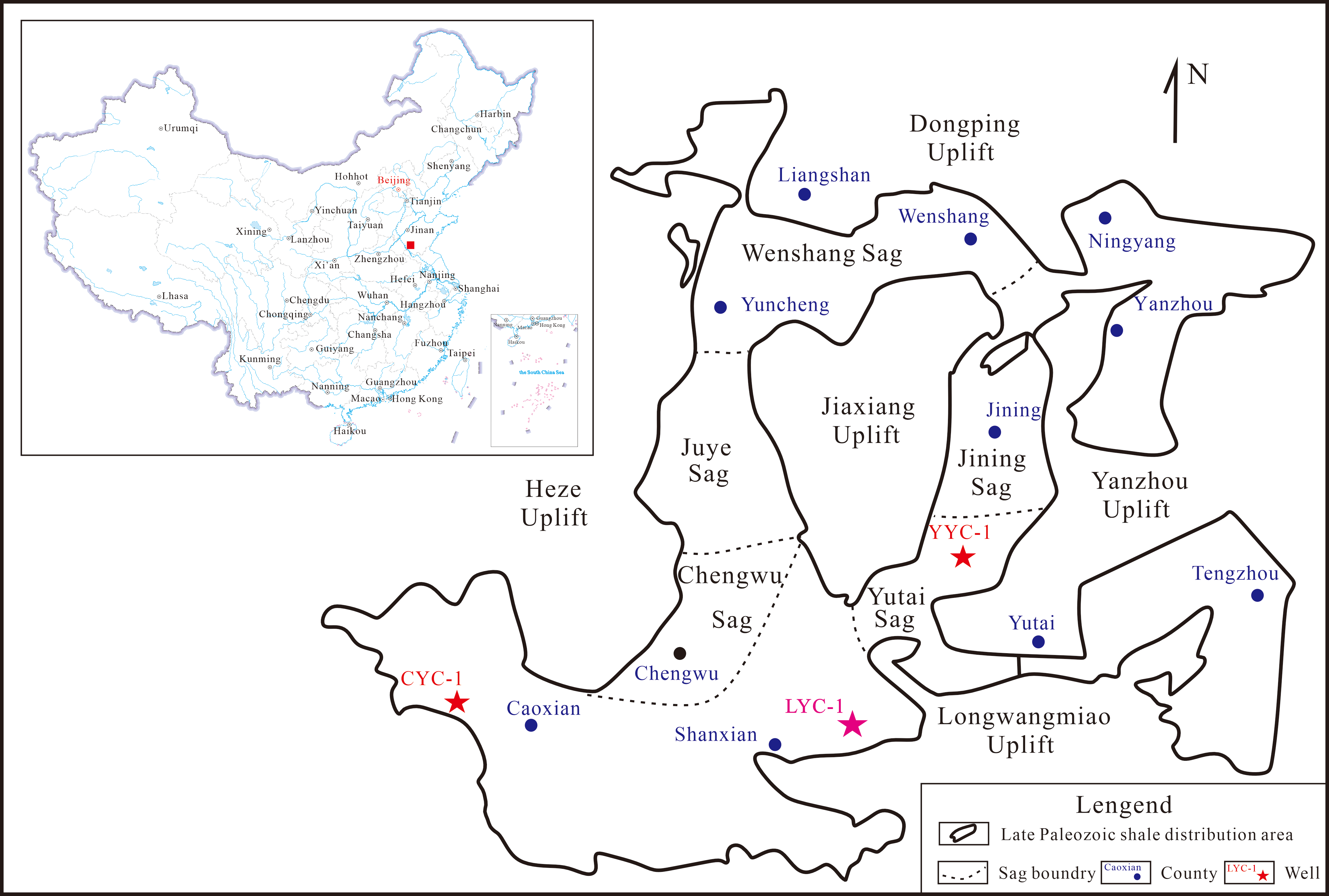
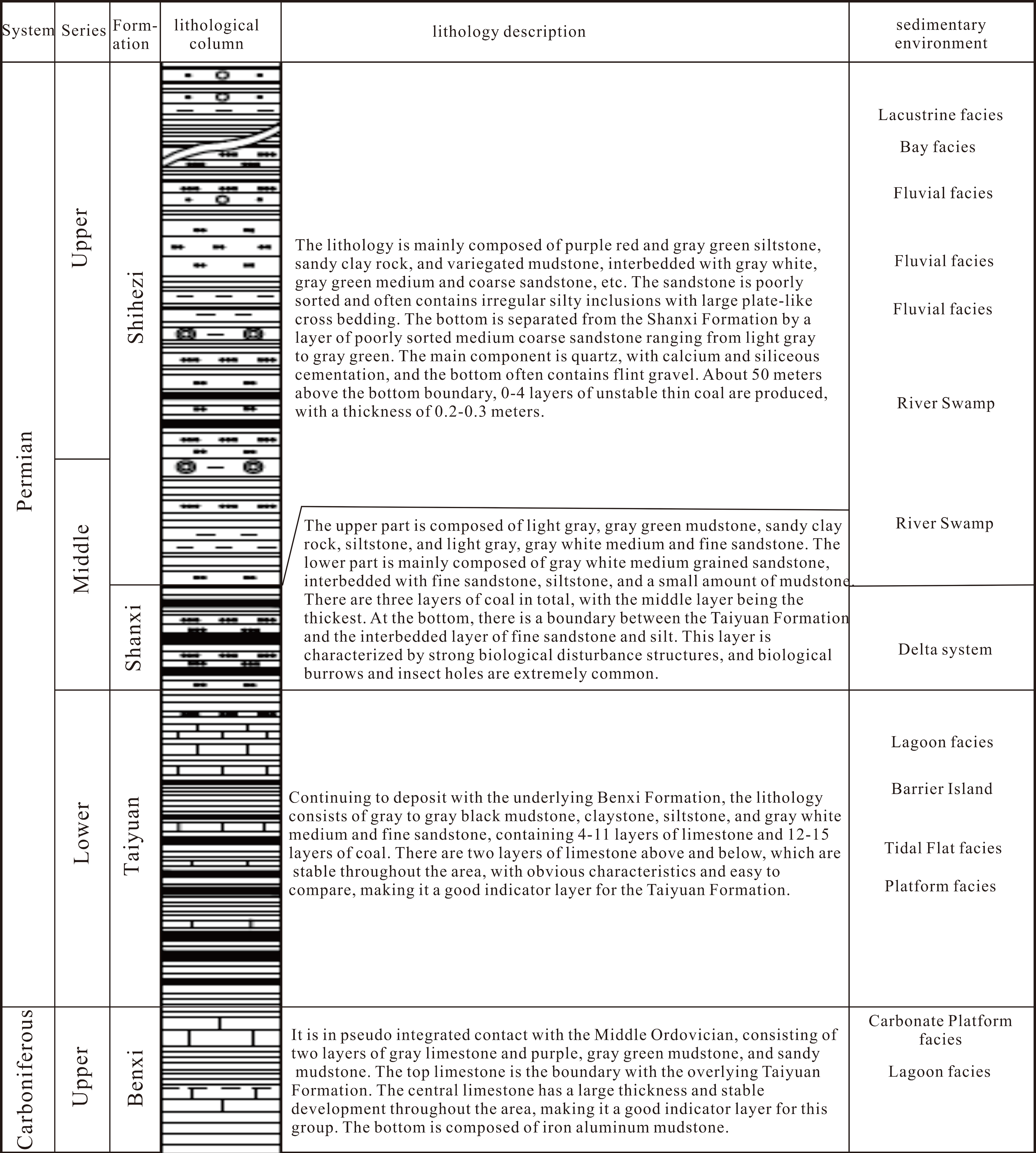


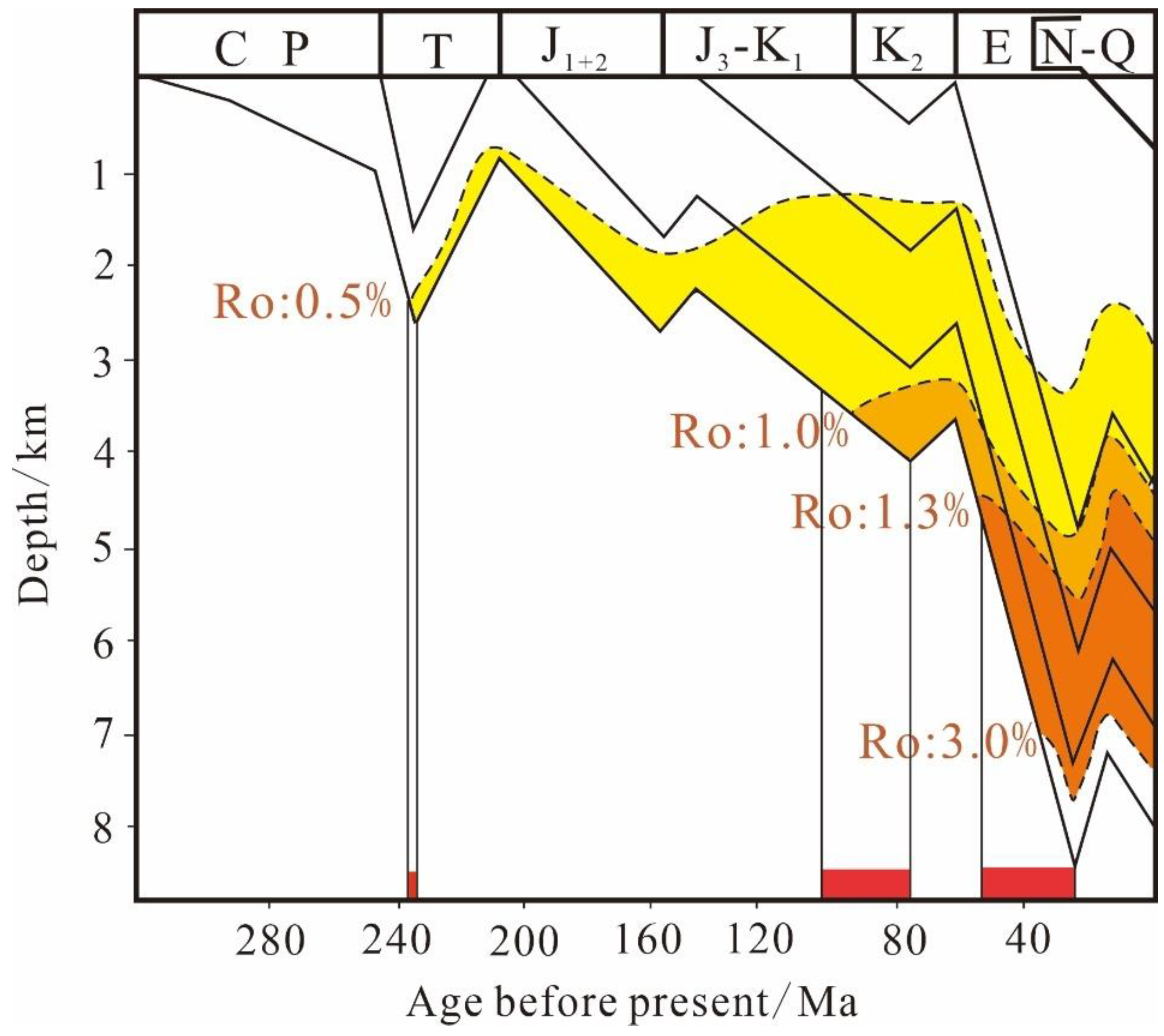
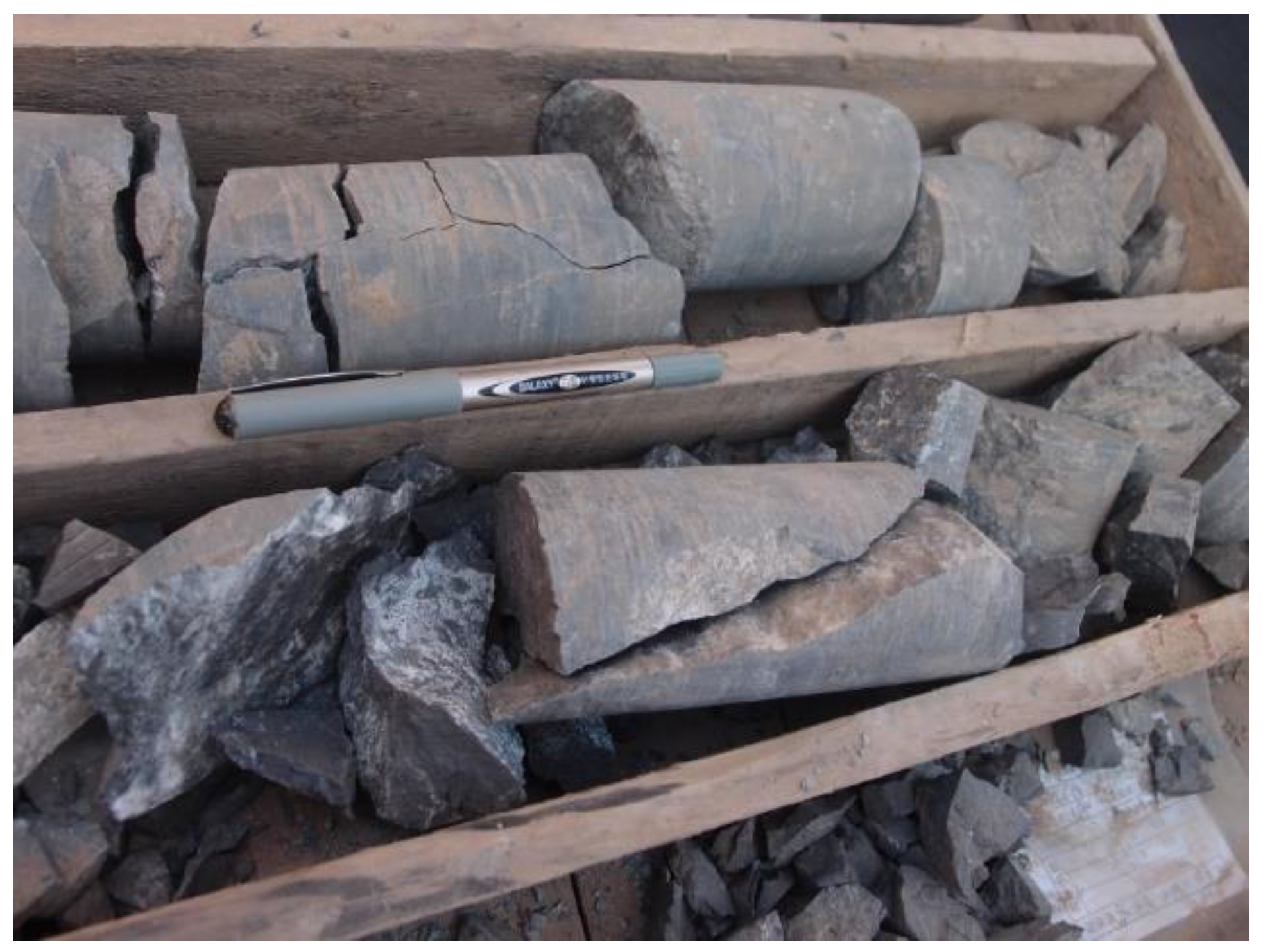
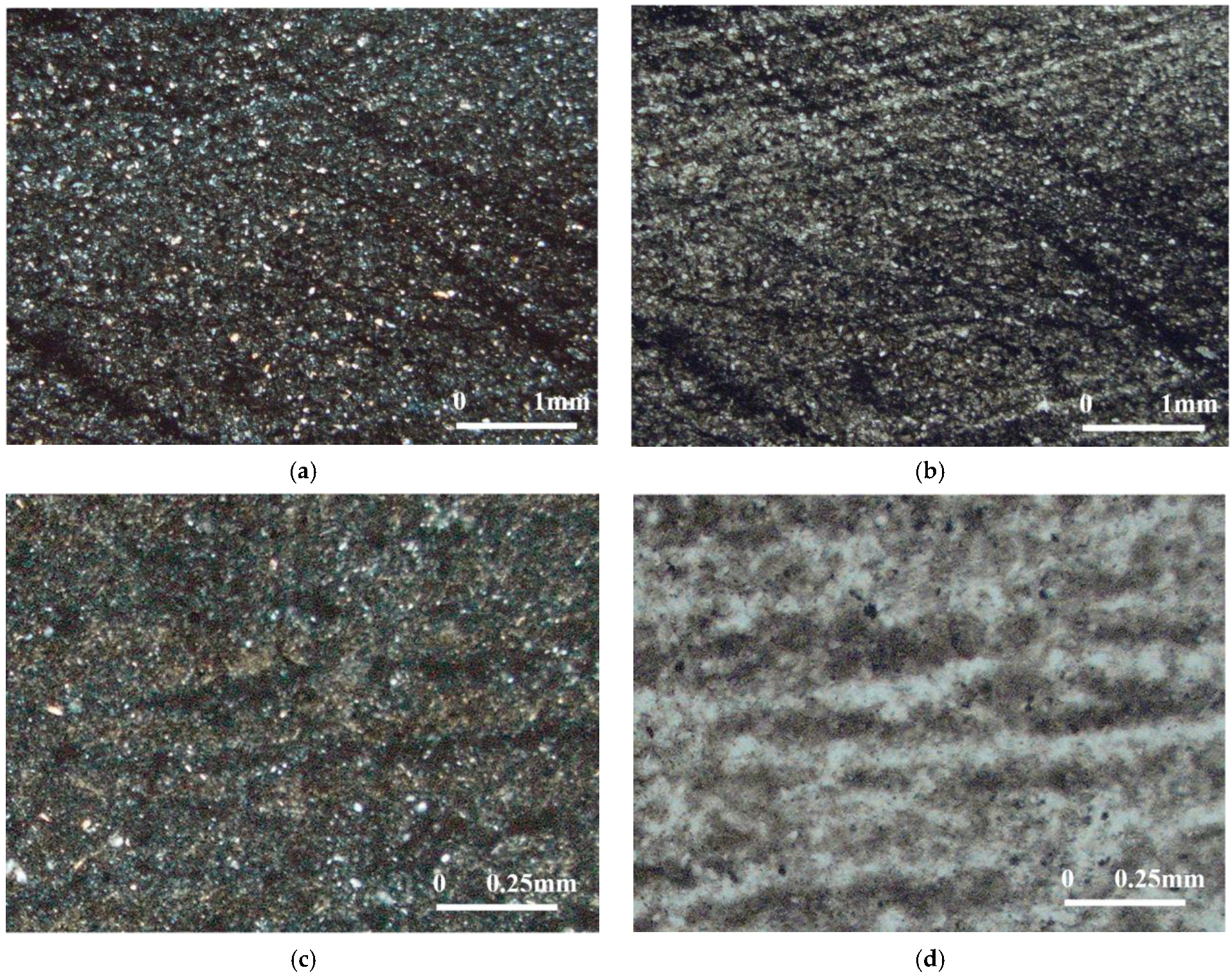

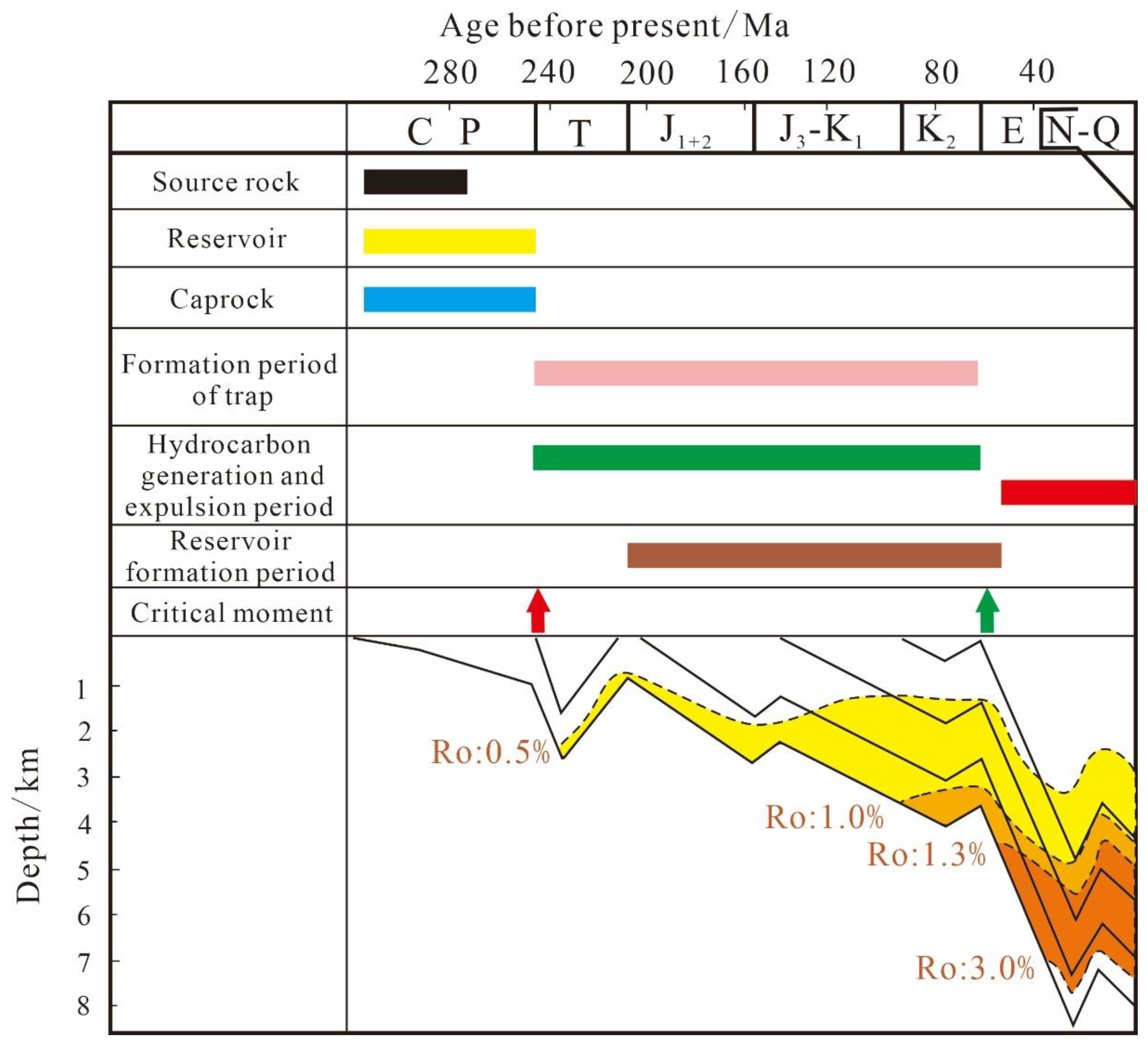
| Parameter | Upper Carboniferous Taiyuan Formation | Lower Permian Shanxi Formation |
|---|---|---|
| TOC Range | 1.5–4.5% (Average: 2.5–3.5%) | 1.0–2.5% (Average: 1.5–2.0%) |
| Kerogen Type | Type II (30–50%) + Type III (50–70%) | Type III (>90%) |
| H/C Atomic Ratio | Type II: 0.9–1.3;Type III: <0.8 | 0.6–0.8 |
| O/C Atomic Ratio | 0.15–0.25 | 0.2–0.3 |
| Hydrocarbon Generation Potential | Moderate (Yield: 2.0–4.0 mg/g) | Low (Yield: 0.5–1.5 mg/g) |
| Thermal Evolution Degree | High-maturity stage (Ro > 1.3%) | Maturity-high maturity stage (Ro > 0.8%) |
| Stratum | Number of Samples | Quartz (%) | Feldspar (%) | Calcite (%) | Dolomite (%) | Pyrite (%) | Clay Minerals (%) | Brittleness Index II (%) |
|---|---|---|---|---|---|---|---|---|
| Taiyuan Formation | 38 | 12.75–73.51 Average: 42.09 | 0–25.93 Average: 8.69 | 0–4.85 Average: 0.16 | 0–9.71 Average: 0.76 | 0–13.15 Average: 2.15 | 12.79–83.15 Average: 43.21 | 13.97–80.73 Average: 52.85 |
| Shanxi Formation | 9 | 45.95–66.87 Average: 52.37 | 1.99–28.76 Average: 16.95 | 0–0.53 Average: 0.09 | 0–1.73 Average: 0.59 | 0–1.99 Average: 0.97 | 8.15–47.29 Average: 28.13 | 48.97–89.15 Average: 70.11 |
| Factors | Evaluation Parameters | Evaluation Levels | |||
|---|---|---|---|---|---|
| Good | Moderately Good | Average | Poor | ||
| Regional Geological Characteristics | Burial Depth (m) | 2000–4000 | 1500–2000 | 1000–1500 | <1000 |
| Areal Extent (km2) | >300 | 100–300 | 50–100 | <50 | |
| Tectonic Geological Processes and Tectonic Evolution History | Distance from Throughgoing Faults (km) | >10 | 5–10 | 2–5 | <2 |
| Development of Giant/Large Fractures | None | Mostly None | Rare | Abundant | |
| Erosion Thickness Since Indosinian Orogeny (m) | Thin | Thick | Relatively Thick | Thickest | |
| Distance from Outcrop to Target Interval (km) | >15 | 10–15 | 5–10 | <5 | |
| Burial History Type | Early long-term shallow burial—Early-middle long-term uplift—Middle-stage secondary deep burial—Late-stage rapid uplift | Early long-term shallow burial—Early-middle long-term uplift—Middle-stage secondary deep burial—Late-stage rapid uplift | Early hydrocarbon generation—Middle-stage multiple hydrocarbon generation/expulsion—Late-stage rapid uplift | Long-term continuous burial—Rapid uplift | |
| Gas Generation Peak (Permian shales) | Latest | Later | Moderate | Early | |
| Gas Generation Peak (Carboniferous shales) | Latest | Later | Moderate | Early | |
| Uncertainty | Future Research Direction |
|---|---|
| The comprehensive evaluation system for shale gas preservation conditions in Western Shandong emphasizes geological factors in parameter selection but lacks integration of multi-source data (e.g., logging, seismic attributes), resulting in suboptimal prediction accuracy (compared to machine learning applications in North America [44]). | Integrate multi-source data (e.g., logging, seismic attributes) and optimize machine learning models to enhance the accuracy of preservation condition evaluations. |
| While the study reveals the spatiotemporal relationship between tectonic movements and secondary hydrocarbon generation, the dynamic impact of thermal fluid activity on kerogen cracking during the Yanshanian rapid subsidence stage remains unclear. | Combine basin simulation and thermal simulation experiments to develop a coupled model of “tectonic stress, organic matter evolution, and fluid migration” to quantify hydrocarbon generation contributions across different tectonic periods. |
| The interwoven distribution of NW-trending faults and NE-trending cracks in Western Shandong introduces significant uncertainty in preservation condition evaluations, particularly regarding prediction accuracy in “sweet-spot areas”. | Use 3D seismic attribute analysis (e.g., curvature volume, coherence volume) and machine learning algorithms (e.g., convolutional neural networks) to construct a preservation unit recognition system spanning millimeter (bedding) to kilometer (sag) scales, contingent on improved regional investigation efforts. |
Disclaimer/Publisher’s Note: The statements, opinions and data contained in all publications are solely those of the individual author(s) and contributor(s) and not of MDPI and/or the editor(s). MDPI and/or the editor(s) disclaim responsibility for any injury to people or property resulting from any ideas, methods, instructions or products referred to in the content. |
© 2025 by the authors. Licensee MDPI, Basel, Switzerland. This article is an open access article distributed under the terms and conditions of the Creative Commons Attribution (CC BY) license (https://creativecommons.org/licenses/by/4.0/).
Share and Cite
Sun, J.; Zhao, Y.; Liang, J.; Zhang, X.; Zhao, Q. Tectonic Controls on Late Paleozoic Shale Gas Preservation in Western Shandong, China. J. Mar. Sci. Eng. 2025, 13, 1121. https://doi.org/10.3390/jmse13061121
Sun J, Zhao Y, Liang J, Zhang X, Zhao Q. Tectonic Controls on Late Paleozoic Shale Gas Preservation in Western Shandong, China. Journal of Marine Science and Engineering. 2025; 13(6):1121. https://doi.org/10.3390/jmse13061121
Chicago/Turabian StyleSun, Jing, Yuting Zhao, Jie Liang, Xiujuan Zhang, and Qingfang Zhao. 2025. "Tectonic Controls on Late Paleozoic Shale Gas Preservation in Western Shandong, China" Journal of Marine Science and Engineering 13, no. 6: 1121. https://doi.org/10.3390/jmse13061121
APA StyleSun, J., Zhao, Y., Liang, J., Zhang, X., & Zhao, Q. (2025). Tectonic Controls on Late Paleozoic Shale Gas Preservation in Western Shandong, China. Journal of Marine Science and Engineering, 13(6), 1121. https://doi.org/10.3390/jmse13061121







